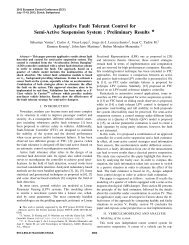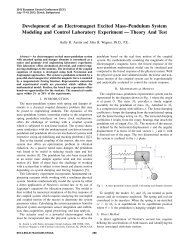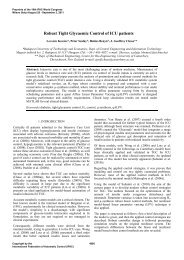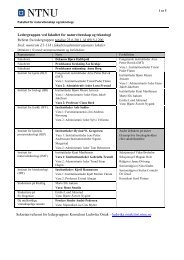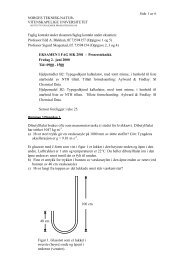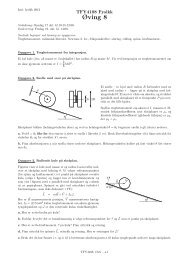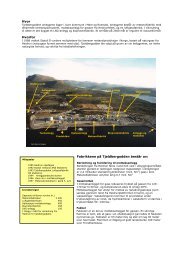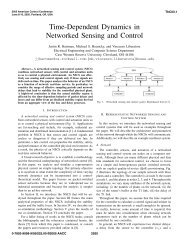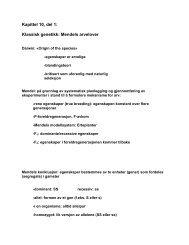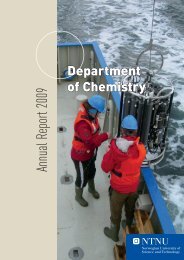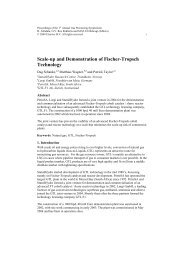Hybrid modeling for continuous production of bioethanol
Hybrid modeling for continuous production of bioethanol
Hybrid modeling for continuous production of bioethanol
Create successful ePaper yourself
Turn your PDF publications into a flip-book with our unique Google optimized e-Paper software.
16th European Symposium on Computer Aided Process Engineering<br />
and 9th International Symposium on Process Systems Engineering<br />
W. Marquardt, C. Pantelides (Editors)<br />
© 2006 Published by Elsevier B.V.<br />
<strong>Hybrid</strong> <strong>modeling</strong> <strong>for</strong> <strong>continuous</strong> <strong>production</strong> <strong>of</strong><br />
<strong>bioethanol</strong><br />
E. Ccopa Rivera, Ivana Mantovaneli, Aline C. da Costa and R. Maciel Filho<br />
Faculty <strong>of</strong> Chemical Engineering, State Universtiy <strong>of</strong> Campinas, Campinas, SP, P.O.<br />
Box 6066, 13081-970, Brazil<br />
Abstract<br />
Changes in the operational conditions are quite common in plants <strong>of</strong> alcoholic<br />
fermentation; they occur not only due to the variations in the quality <strong>of</strong> the raw material<br />
but also due to variations <strong>of</strong> dominant yeast in the process. Thus, it is clear that the main<br />
difficulty in model-based techniques <strong>for</strong> definition <strong>of</strong> operational strategies, control and<br />
optimization, is the problem <strong>of</strong> obtaining a reliable model. This work proposes the use<br />
<strong>of</strong> hybrid models <strong>for</strong> <strong>continuous</strong> <strong>production</strong> <strong>of</strong> <strong>bioethanol</strong> plants. The hybrid model<br />
comprises first a system <strong>of</strong> differential equations describing the mass and energy<br />
balances <strong>of</strong> the process. Complementary to the mass and energy balances, the kinetic<br />
rates <strong>of</strong> the biological system are obtained by neural network sub-models. Multilayer<br />
perceptron neural networks <strong>for</strong> an Extractive Alcoholic Fermentation Process and<br />
Functional Link Networks <strong>for</strong> an Alcoholic Fermentation Process with Multiples Stages<br />
were used <strong>for</strong> <strong>modeling</strong> the kinetic. The results show that typical non-linearities present<br />
in this kind <strong>of</strong> bioprocesses are adequately represented. Agreement between predicted<br />
and operating data was very good. The models are reliable enough to be used <strong>for</strong> further<br />
optimization and control studies.<br />
Keywords: Bioethanol, <strong>Hybrid</strong> <strong>modeling</strong>, Multilayer Perceptron Neural Network,<br />
Functional Link Network.<br />
1. Introduction<br />
A potential substitute <strong>for</strong> petroleum in Brazil and in several countries may be biomass,<br />
particularly sugar cane. The sugar cane industry keeps the greatest commercial energy<br />
<strong>production</strong> in the world with ethanol and the almost complete use <strong>of</strong> sugar cane bagasse<br />
as a fuel. Brazilian annual <strong>production</strong> capacity <strong>of</strong> ethanol is currently in 18 billions <strong>of</strong><br />
liters and, with the increase in demand, the idea is to multiply this capacity through the<br />
installation <strong>of</strong> new factories and optimization <strong>of</strong> the operation <strong>of</strong> the existing ones.<br />
Thus, there is an intensified interest in the study <strong>of</strong> all the steps involved in ethanol<br />
<strong>production</strong>.<br />
Among the main problems related to the alcoholic fermentation process is the lack <strong>of</strong><br />
robustness <strong>of</strong> the fermentation in the presence <strong>of</strong> fluctuations in the quality <strong>of</strong> the raw<br />
material and modifications in microbial metabolism. These lead to changes in the<br />
kinetic behavior with impact on yield, productivity and conversion <strong>of</strong> the process. The<br />
lack <strong>of</strong> robustness can be corrected by adjustments in the operational and control<br />
parameters <strong>of</strong> the process when fluctuations occur. In order to accomplish this, it is<br />
important that a mathematical model be available to aid in the decision making, mainly<br />
when the difficulties <strong>of</strong> monitoring the key process variables (concentrations <strong>of</strong><br />
biomass, substrate and ethanol) are taken into account. However, the operational<br />
changes described make the prediction <strong>of</strong> the dynamic behavior <strong>of</strong> the process with a<br />
single model difficult, as they lead to changes in microorganism kinetics. Thus, it would<br />
613
614<br />
be <strong>of</strong> great advantage to have a mathematical model that could be easily adapted to<br />
changes in operational conditions. A way to deal with this problem is to use hybrid<br />
neural models. These models are expected to per<strong>for</strong>m better than “black-box” neural<br />
network models (pure ANN models), since generalization and extrapolation are<br />
confined only to the uncertain parts <strong>of</strong> the process and the basic model is always<br />
consistent with first principles. Besides, significantly fewer data are required <strong>for</strong> their<br />
training. Several authors have applied hybrid <strong>modeling</strong> <strong>for</strong> bioprocesses (e.g. Pischogios<br />
and Ungar, 1992; Zorzetto et al., 2000) In particular Harada et al. (2002) and Costa et<br />
al. (2001) dealt with the hybrid <strong>modeling</strong> <strong>of</strong> the alcoholic fermentation process.<br />
The objective <strong>of</strong> this work is to investigate the use <strong>of</strong> hybrid models to describe<br />
<strong>continuous</strong> <strong>production</strong> <strong>of</strong> <strong>bioethanol</strong> in order to obtain a fast and easy model to be used<br />
<strong>for</strong> on-line implementation. <strong>Hybrid</strong> models have been developed based on first<br />
principles (physical knowledge) associated with Artificial Neural Networks (ANN).<br />
Multilayer Perceptron Neural Networks (MLPNN) were used <strong>for</strong> an Extractive<br />
Alcoholic Fermentation Process and Functional Link Networks (FLN) were used <strong>for</strong><br />
<strong>modeling</strong> the kinetic <strong>of</strong> an Alcoholic Fermentation Process with Multiples Stages.<br />
Hence, in this work a tool is developed to build up hybrid models with relatively<br />
smaller amount <strong>of</strong> data compared to the “black-box” approach required <strong>for</strong> process<br />
identification exploring the benefits <strong>of</strong> two different ANN structures.<br />
1.1. Hibrid Models<br />
Psichogios and Ungar (1992) were among the first who proposed the serial approach <strong>for</strong><br />
hybrid <strong>modeling</strong> <strong>of</strong> bioprocess. The kinetics relations are modeled by a static mapping<br />
<strong>of</strong> process states to biomass specific rates. Thus, the function to be learned by the ANN<br />
is static, while the process dynamics are represented by the differential equations <strong>of</strong> the<br />
model. As noted by Psichogios and Ungar (1992), the hybrid approach provides better<br />
predictions than “black box” <strong>modeling</strong> <strong>of</strong> bioprocesses with a pure neural network<br />
approach.<br />
In this work, it was used two different ANNs: MLPNN, which are able to approximate<br />
generic classes <strong>of</strong> functions, including <strong>continuous</strong> and integrable ones, and FLN, which<br />
have good non-linear approximation ability with the advantage that the estimation <strong>of</strong><br />
their weights is a linear optimization problem. The use <strong>of</strong> the MLPNN structure has<br />
been proved to be a good approach (Zorzetto et al, 2000), however there is a large<br />
incentive to use ANN structures that are quicker to be identified and easier to be<br />
implemented, such as the FLNs. This is particularly interesting <strong>for</strong> control and on-line<br />
optimization applications.<br />
1.2. Multilayer Perceptron Neural Network (MLPNN)<br />
A MLPNN consists <strong>of</strong> three types <strong>of</strong> layers: an input layer, an output layer and one or<br />
more hidden layers. Each layer may have a different number <strong>of</strong> neurons, and even a<br />
different transfer function. An appropriate architecture would help to achieve higher<br />
model accuracy. It has been shown that all <strong>continuous</strong> functions can be approximated to<br />
any desired accuracy, with a network <strong>of</strong> one hidden layer <strong>of</strong> sigmoidal<br />
−X<br />
f (X) = 1/(1+ exp ) hidden units (nodes) and a layer <strong>of</strong> linear output nodes. Such<br />
structure was used in this work. Eq. (1) describes mathematically a MLPNN.<br />
M N<br />
1 = 1[ 1j j( jlX l + j0)<br />
+ 10]<br />
j= 1 l=<br />
1<br />
∑ ∑ (1)<br />
y F W f w w W<br />
E. Ccopa Rivera et al.<br />
In Eq. (1), wj,l and W1,j specifies the adjustable parameters; i.e., the weights and biases.<br />
X is the input variable <strong>of</strong> the network.
<strong>Hybrid</strong> Modeling <strong>for</strong> Continuous Production <strong>of</strong> Bioethanol 615<br />
1.3. Functional Link Network (FLN)<br />
The FLN was developed by Pao (1989) to increase the computing power <strong>of</strong> neural<br />
networks. The input-output relationship <strong>of</strong> the FLN is represented by Eq. (2).<br />
M<br />
y (X ) = ∑ w h (X ) , 1 ≤ i ≤ m (2)<br />
i e ij j e<br />
j=<br />
1<br />
In the general structure <strong>of</strong> an FLN the hidden layer per<strong>for</strong>ms a functional expansion on<br />
the inputs which maps the input space, <strong>of</strong> dimension n, onto a new space <strong>of</strong> increased<br />
dimension, Mz(Mz>nz). In this case, the expansion results, hj(Xe), are a series <strong>of</strong><br />
monomials <strong>of</strong> Xe. The output layer consists on m nodes, each one, in fact, a linear<br />
combiner, and each wij is an FLN weight.<br />
In these networks, a non-linear functional trans<strong>for</strong>m or expansion <strong>of</strong> the network inputs<br />
is initially per<strong>for</strong>med and the resulting terms are linearly combined. More details about<br />
the FLNs can be found in Costa et al. (1999).<br />
2. Building up the models<br />
This section shows the models development through the hybrid approach <strong>for</strong> a<br />
<strong>continuous</strong> extractive alcoholic fermentation process and a <strong>continuous</strong> alcoholic<br />
fermentation process with multiples stages.<br />
2.1. Case study 1: Extractive alcoholic fermentation process<br />
High concentrations <strong>of</strong> ethanol inhibit the fermentation process, particularly when a<br />
fermentative medium with high concentration <strong>of</strong> substrate is used, as is the case in the<br />
majority <strong>of</strong> the industrial processes. Taking these into account, a process <strong>of</strong><br />
fermentation combined with a vacuum flash vessel was considered, which selectively<br />
extracts ethanol from the medium as soon as it is produced. The process is composed <strong>of</strong><br />
four interlinked units: fermentor (ethanol <strong>production</strong> unit), centrifuge (cell separation<br />
unit), cell treatment unit and vacuum flash vessel (ethanol–water separation unit). It was<br />
shown that this scheme presents many positive features and better per<strong>for</strong>mance than a<br />
conventional industrial process. The extractive alcoholic fermentation process is shown<br />
in Figure 1. A detailed description <strong>of</strong> the process and mathematical model can be found<br />
in Costa et al. (2001).<br />
F 0, S 0, T 0<br />
F R , S R , X R , P R , T R<br />
F, S F , X F , P F , T F<br />
F W , T W<br />
F LR , S LR , X LR , P LR , T LR<br />
Fc1 T<br />
R<br />
E<br />
A<br />
T.<br />
air<br />
FERM.<br />
CO2 air<br />
F, S, X, P, T<br />
F P<br />
Fc, S, Xc, P, T<br />
F E , S, X E , P, T<br />
CENTRIFUGUE<br />
Figure 1. Extractive alcoholic fermentation (Costa et al., 2001).<br />
F<br />
L<br />
A<br />
S<br />
H<br />
F V, P V, T V<br />
F L<br />
F LS
616<br />
2.2. Case study 2: Alcoholic Fermentation Process with Multiples Stages<br />
F0<br />
FW<br />
Cooler<br />
FR<br />
1<br />
2<br />
3<br />
4<br />
Cooler<br />
Cooler<br />
5<br />
Cooler<br />
acid<br />
water, Fa<br />
Cooler<br />
Heavy Phase<br />
FS<br />
Purge<br />
Stream<br />
air<br />
Surge Tank<br />
Centrifuge<br />
FV<br />
Light Phase<br />
Figure 2. Alcoholic fermentation process with multiples stages (Andrietta and Maugeri, 1994).<br />
The fermentative process is illustrated in Figure 2. The system is a typical large-scale<br />
industrial process made up <strong>of</strong> five <strong>continuous</strong>-stirred tank reactors (CSTR) attached in<br />
series and operating with cells recycle. Each reactor has an external heat exchanger<br />
whose objective is to keep the temperature constant at an ideal level <strong>for</strong> the fermentation<br />
process. This process operating conditions are real conditions <strong>of</strong> typical industrial<br />
distillers in Brazil. More details about this process are given by Andrietta and Maugeri<br />
(1994).<br />
2.3. Training and Validation<br />
The training was per<strong>for</strong>med using a full factorial design 2 2 +star configuration, involving<br />
the variables S0 (kg/m 3 ) and T0 ( o C). Both variables had their values changed every 10<br />
hours (this period was sufficient to reach the steady state) within the ranges 90 kg/m 3 to<br />
270 kg/m 3 (S0) and 28°C to 40°C (T0) <strong>for</strong> Case 1 and 150 kg/m 3 to 210 kg/m 3 (S0) and<br />
28°C to 35°C (T0) <strong>for</strong> Case 2. Thus, representative data containing the input and output<br />
signals <strong>of</strong> the process was generated. For validation, the disturbances were also a<br />
sequence <strong>of</strong> steps with periods <strong>of</strong> 10 hours within the operational interval 120 kg/m 3 to<br />
230 kg/m 3 (S0) and 30°C to 38°C (T0) <strong>for</strong> Case 1 and 162 kg/m 3 to 198 kg/m 3 (S0) and<br />
28°C to 32°C (T0) <strong>for</strong> Case 2.<br />
For the current cases, the specific rates <strong>of</strong> microbial growth were modeled with an ANN<br />
with four inputs (concentrations <strong>of</strong> biomass, substrate and ethanol, and temperature).<br />
2.4. Quality <strong>of</strong> Prediction<br />
The quality <strong>of</strong> prediction <strong>of</strong> the proposed hybrid models was given by the residual<br />
standard deviation (RSD), Eq. (3), which provides an indication <strong>of</strong> the accuracy <strong>of</strong> the<br />
predictions.<br />
1<br />
RSD= ( ( - ) )<br />
n<br />
2 0.5<br />
yi yPi<br />
n i=1<br />
∑ (3)<br />
In this equation yi is the ‘real’ value (calculated by the deterministic model), yPi is the<br />
value predicted by the hybrid model and n is the number <strong>of</strong> points. The magnitude <strong>of</strong><br />
the RSD changes depends upon the magnitude <strong>of</strong> the variable to be predicted. It is<br />
worthwhile mentioning that it is easier to analyze the RSD as a percentage <strong>of</strong> the<br />
average <strong>of</strong> the real values y i (Atala et al., 2001), Eq. (4).<br />
RSD<br />
RSD(%) = × 100<br />
(4)<br />
y<br />
i<br />
E. Ccopa Rivera et al.
<strong>Hybrid</strong> Modeling <strong>for</strong> Continuous Production <strong>of</strong> Bioethanol<br />
3. Results and Discussions<br />
The developed hybrid models described well the simulation data. Figures 3(a) and<br />
Figure 3(b) <strong>for</strong> Case 1 and Case 2, respectively, show the results which indicate the<br />
good per<strong>for</strong>mance <strong>of</strong> the hybrid model <strong>for</strong> ethanol concentration.<br />
Table 1 <strong>for</strong> Case 1 and Table 2 <strong>for</strong> Case 2, shows the prediction results <strong>of</strong> the hybrid<br />
model <strong>for</strong> concentrations <strong>of</strong> biomass, substrate and ethanol, and temperature.<br />
The range <strong>of</strong> deviations were from 0.019% to 0.649% and 0.002% to 1.973% <strong>for</strong> Case 1<br />
and Case 2, respectively. Deviations below 10% are considered acceptable regarding<br />
bioprocess engineering (Atala et al., 2001). These results show that this model is<br />
reliable enough to be further used <strong>for</strong> optimization and control studies.<br />
P [Kg/m 3 ]<br />
40<br />
37<br />
34<br />
31<br />
28<br />
25<br />
0 20 40 60 80<br />
(a) (b)<br />
Time [h]<br />
P 5 [Kg/m 3 ]<br />
72<br />
69<br />
66<br />
63<br />
60<br />
57<br />
0 20 40 60 80<br />
Time [h]<br />
Figure 3. Process output (solid line) and synthetic data <strong>of</strong> the hybrid model (dashed line): (a) Case<br />
study 1; validation data <strong>for</strong> ethanol concentration, P, into the reactor. (b) Case study 2; validation<br />
data <strong>for</strong> ethanol concentration, P 5, <strong>of</strong> last (fifth) reactor.<br />
Reactor<br />
(i)<br />
Table 1. Residual Standard Deviation <strong>for</strong> Case study 1<br />
Output variable RSD (%)<br />
Biomass (X) 0.019<br />
Substrate (S) 0.649<br />
Ethanol (P) 0.359<br />
Temperature (T) 0.042<br />
Table 2. Residual Standard Deviation <strong>for</strong> Case study 2<br />
RSD(%)<br />
Biomass (X i) Substrate (S i) Ethanol (P i) Temperature (T i)<br />
1 0.0037 0.151 0.0323 0.0087<br />
2 0.0021 0.309 0.0147 0.0049<br />
3 0.0020 0.754 0.0126 0.0100<br />
4 0.0024 1.429 0.0149 0.0125<br />
5 0.0023 1.973 0.0143 0.0126<br />
4. Conclusions<br />
Bioreactors operating in <strong>continuous</strong> steady state are quite difficult to model, since<br />
their operation involves microbial growth under constantly changing conditions. Hence,<br />
there is a need <strong>for</strong> the development <strong>of</strong> simple though realistic mathematical descriptions<br />
617
618<br />
<strong>of</strong> alcoholic fermentation process, which can be used to develop optimal operating<br />
strategies. This work demonstrated that hybrid model coupling deterministic<br />
representation with universal approximators (MLPNN) or linear combination <strong>of</strong><br />
expanded input variables (FLN) was able to describe the fermentative processes with<br />
good per<strong>for</strong>mance. The residual standard deviations (RSD%) showed low values.<br />
There<strong>for</strong>e, the developed models may be used to predict system per<strong>for</strong>mance and to<br />
design process controllers. It is worthwhile mentioning that the proposed approach <strong>for</strong><br />
hybrid <strong>modeling</strong> is able to deal with disturbances in transient phases <strong>of</strong> the process and<br />
different yeasts since the identification procedures be carried out adequately with a<br />
suitable set <strong>of</strong> data representative <strong>of</strong> the process.<br />
References<br />
Andrietta, S.R. and Maugeri, F., Optimum design <strong>of</strong> a <strong>continuous</strong> fermentation unit <strong>of</strong> an<br />
industrial plant <strong>for</strong> alcohol <strong>production</strong>. Advances in Bioprocess Engineering, 1994, 1 47-52.<br />
Atala, D.I.P., Costa, A.C., Maciel, R. and Maugeri, F., Kinetics <strong>of</strong> ethanol fermentation with high<br />
biomass concentration considering the effect <strong>of</strong> temperature. Applied Biochemistry and<br />
Biotechnology, 2001, 91-93(1-9) 353-366.<br />
Costa, A.C., Henriques, A.W.S, Alves, T,L.M, Lima, E.L. and Maciel Filho, R., A hybrid neural<br />
model <strong>for</strong> the optimization <strong>of</strong> fed-batch fermentations. Brazilian Journal <strong>of</strong> Chemical<br />
Engineering., 1999, 37 125-137.<br />
Costa, A.C., Atala, D.I.P., Maugeri, F. and Maciel Filho, R., Factorial design and simulation <strong>for</strong><br />
the optimization and determination <strong>of</strong> control structures <strong>for</strong> an extractive alcoholic<br />
fermentation. Process Biochemistry, 2001, 37 125-137.<br />
Harada, L.H.P., Costa, A.C. and Maciel Filho, R., <strong>Hybrid</strong> neural <strong>modeling</strong> <strong>of</strong> bioprocess using<br />
functional link networks. Applied Biochemistry and Biotechnology, 2002, 98-100(1-9) 1009-<br />
1024.<br />
Pao,Y. H. Adaptive Pattern Recognition and Neural Networks. Addison-Wesley Publishing<br />
Company, Cali<strong>for</strong>nia, 1989.<br />
Psichogios, D.C. and Ungar, L.H., A hybrid neural network-first principles approach to process<br />
<strong>modeling</strong>. American Institute <strong>of</strong> Chemical Engineers Journal, 1992, 38 1499–1511.<br />
Zorzetto, L.F.M., Maciel Filho, R. and Wolf-Maciel, M.R., Process modelling development<br />
through artificial neural networks and hybrid models. Computers and Chemical Engineering,<br />
2000, 24 1355–1360.<br />
Acknowledgements<br />
The authors acknowledge FAPESP and CNPq <strong>for</strong> financial support.<br />
E. Ccopa Rivera et al.



